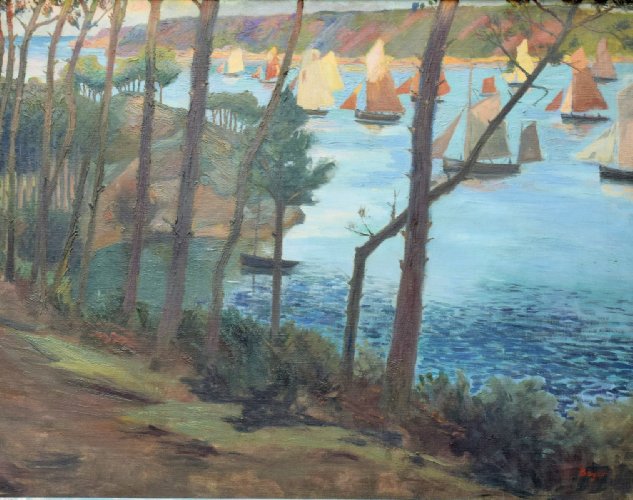Description:
The painting transports us to the Côtes-d’Armor department of Brittany (formerly called Côtes-du-Nord). The titular town is situated on the edge of the Trieux River estuary, a few kilometers from where it flows into the La Manche canal. Thanks to this, the port located there is the only one in the region naturally protected from storms. This has long favored the development of sailing, of which the author of the painting was also a great enthusiast.
Pierre Boyer (1865-1933) was the son of Marie-Herminie Blavier and Eugène Boyer, the director of the Ministry of Public Works. Boyer combined his legal studies in Paris with learning at the local School of Fine Arts, where he met Alfred Rolle, his teacher, and eventually his friend.
On vacation in Cannes, he met Thérèse Fleury (1972-1909), who reportedly, upon seeing his boat, declared that she wanted to marry its owner. That same evening they got to know each other, and in 1900 they married in Versailles. After the wedding, they settled in a small house by the Trieux River near Lezardrieux, where their two daughters were born, who together with his wife were his favorite models.
A few years later they moved to Saint-Quay-Portrieux, where the artist had a larger studio and more yachts, on which he took part in regattas. He also sailed to Holland and England, where he painted and sold his paintings. However, he was primarily fascinated by the landscape, light and everyday life of Brittany. This was reflected in numerous maritime, landscape and genre compositions that he exhibited at the Salons of the Société Nationale des Beaux-Arts, at the Charpentier Gallery in Paris, and at the Society of Fine Arts in Nantes. He was also a member of the Autumn Salon. Many Alpine landscapes remain from his wife’s stay at the sanatorium in Davos. Unfortunately, in 1909 Teresa died there of tuberculosis. His participation in the First World War earned him the Legion of Honour and the Croix de Guerre and the acquaintance of Alice Florin, his second wife. After the war he moved with his family permanently to Tunisia, which he already knew from his youth trip. He made it around 1890 with his friend Joseph Caillaux, future Minister of Finance and then President of the Council.
On his farm Ben-Aech located not far from Grombalii southeast of Tuni-su, he cultivated the land and still painted, taking advantage of the local light.
In 1923, he founded the Art Teaching Centre in Tunis, which in 1930 was renamed the École des Beaux-Arts de Tunis, and Boyer was its first director and teacher of art history. The artist died in 1933 and is buried with his second wife at the cemetery in Ben-Aech.
Description of the painting:
“River at Lézardrieux” was exhibited in 1899 at the Paris Salon Société Nationale des Beaux-Arts, where it was most likely purchased by Edward Aleksander Raczyński for his collection, and eventually placed in the first room of the Rogaliński Gallery. There we will find it.
In the setting sun we see the titular river, calmly flowing between tall, green banks. It is heading, like the numerous boats sailing on it, towards the mouth of the ocean which can be seen in the upper left corner of the canvas. The bank in the foreground is sinking in the shadow of tall trees, the crowns of which are not visible from this perspective. Their slender trunks give the composition a rhythm and balance the patch-diagonal structure of the painting. This task is assisted by a row of pines growing on the peninsula to the left, with trunks clearly standing out against the blue of the water and crowns half lit by the setting sun. Its last rays also fall on the brown-beige sails of boats slowly moving in the evening breeze. The delicate breath of the wind is visible on the slightly wrinkled water of the small bay, shaded by the trees of the foreground. The wrinkled water, painted with small brushstrokes, stands out from the rest of the scenery, the boundary of which is marked by a moored sailboat in the bay. The uniform surface of the main stream of the river and the boats flowing along it, as well as the green-brown-violet line of the second bank and the narrow strip of sky visible in the background, were treated in a simplified, synthetic way, painted with flat patches of color.
On the one hand it reveals the knowledge of pointillism, and on the other hand the synthesism of Paul Gauguin. There is also an influence of the then fashionable Japanese woodcut and secession, which influenced the way of painting trees. In one of his works, the artist combined his pointillist experiences, known from his painting “Voiles rouges dans la baie (Red Sails in the Bay)”, with the synthetico-secessionist style of the canvas “Le Trieux” with a clearly symbolic message.


